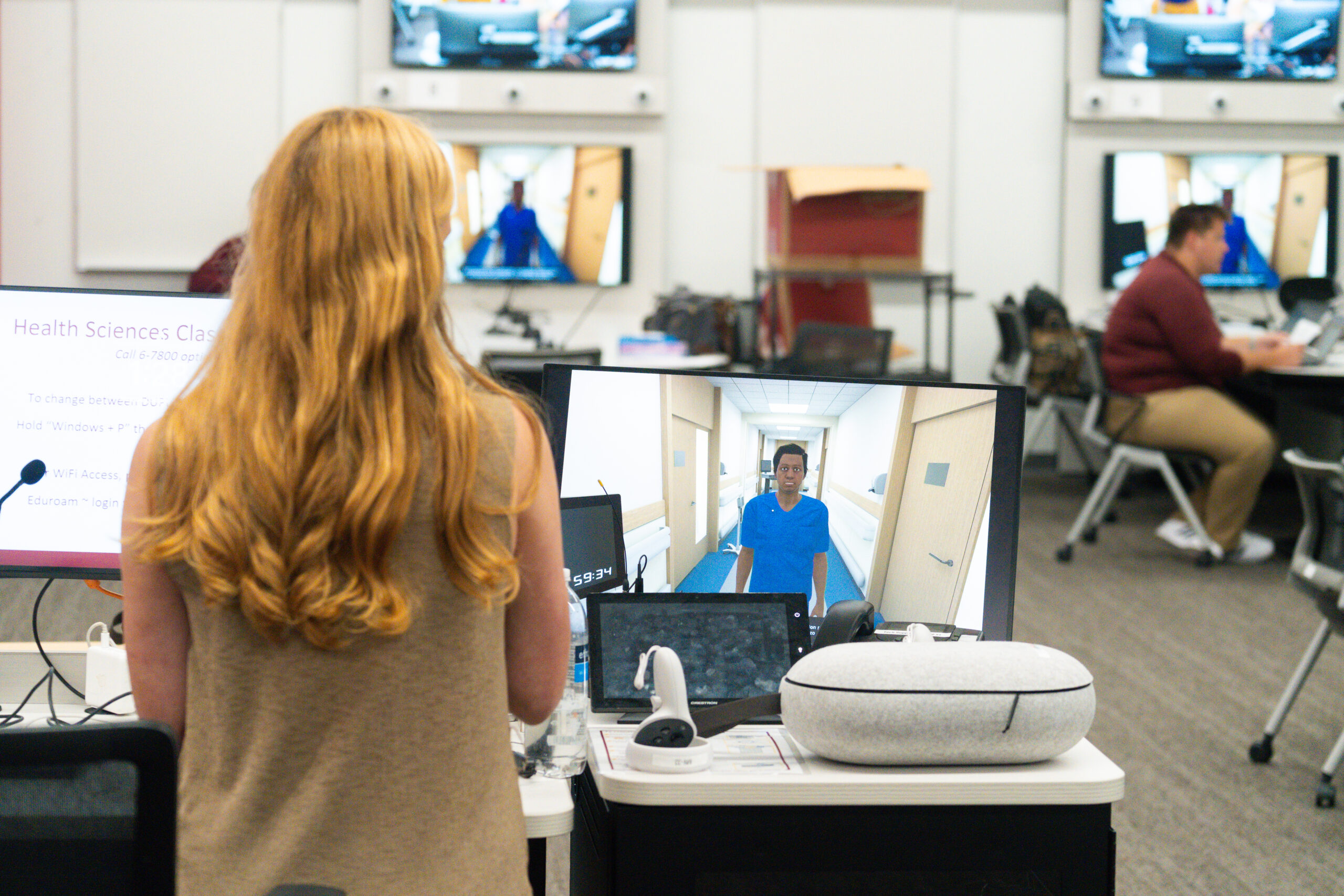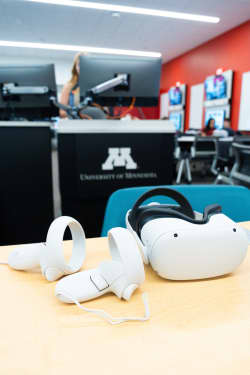At the University of Minnesota School of Nursing, Virtual Reality Helps Train and Retain

- The University of Minnesota has the first virtual reality program on the market to allow students to care for two patients in separate rooms in one simulation.
- Cynthia Bradley is the director of simulation for the University of Minnesota School of Nursing and leads the Big 10 Practice-Ready Nursing Initiative to enhance simulation to better prepare nursing students for the field.
- Bradley believes the technology can help retain more nurses by better preparing students for the realities of work after graduation.
Some University of Minnesota (UMN) nursing students are getting a surprisingly lifelike preview of clinical practice — all thanks to virtual reality (VR). Because of the university’s novel VR model, students can practice caring for multiple patients by themselves, administering medication, and working with diverse teams of healthcare professionals.
The school’s bachelor of science in nursing (BSN) senior class is taking part in immersive VR modules thanks to a $1.3 million gift from the American Nurses Foundation (ANF) as part of its Reimagining Nursing Initiative.
NurseJournal spoke with Cynthia Bradley, Ph.D., BSN, the director of simulation for UMN’s School of Nursing and leader of the Big 10 Practice-Ready Nursing Initiative, a partnership between UMN, Purdue University, and the University of Michigan to better prepare nursing students for professional healthcare careers through emerging technologies and simulations.

Bradley said UMN has been trying to get into VR for several years, conducting pilot projects with the university’s computer science and engineering departments. Thanks to the foundation’s gift, UMN partnered with Oxford Medical Simulation to develop the current immersive VR experience using the Oculus headset.
“If you look at how VR is being used now, we’re starting to see some uses of immersive VR like that to reduce pain symptoms, alleviate symptoms of PTSD, and we’re seeing a lot of work with patients with dementia,” Bradley told NurseJournal. “So, if you think about the power of presence that can reduce your pain, how does that translate to a student learning to be a nurse?”
She said students can feel awkward in traditional simulations because they know everyone is watching them and that the human patient is an actor.
“But in VR, really leveraging that power of immersion without somebody right there with them,” Bradley said. “They felt like it was real. They felt the pressure of, ‘Okay, this patient is short of breath or is having pain,’ and they loved that they were independent — they didn’t have an instructor with them, they didn’t have a peer. It was just them having to make these decisions.”
UMN has used traditional mannequin simulations and actors as patients. Now, students have access to the first virtual reality program on the market to allow them to “travel” between rooms to care for more than one patient.
Bradley told NurseJournal they put students in a hospital unit as if they were going into a hospital shift. Students get a handoff report about their patients and then treat two patients, one in each room.
Abby Grund said it was initially intimidating since nursing school grades everything.
Grund is a lab assistant at the Bentson Healthy Communities Innovation Center and was one of the first students to use the VR program.
“I think the first time I had it, it showed me I had 30% on it, and I’m like, ‘Oh my goodness, I just failed that!’ And then they made it very clear that it’s okay; this is a learning experience,” Grund told NurseJournal. “You’re supposed to not do great on it.”
Grund said the simulations would add on another patient each day while keeping the prior week’s patient so you would see a continuum of care in a clinical setting.
So the question UMN is asking for VR is: Here’s what an actual caseload of patients looks like for the average nurse. Does VR help improve their preparation and understanding of what it’s like to work in the field?
“There’s a lot of mental energy and stress when you have three, four, five, six patients, and every one of them has pain, or they’re throwing up, or you’ve got a physician on the phone calling for this, or they need to go for a test, or you’ve got to discharge them,” Bradley said. “How do you balance all of those things? You don’t learn that until you’ve been able to practice that.”

Interacting With Virtual Patients
Students using the VR devices can choose from option menus to speak to their virtual patients. Some scenarios are still being fleshed out, with the potential for voice-activated student-patient interactions and improved conversation capabilities.

Limited conversation capabilities aren’t limiting students’ capacity for building empathy and compassion through the VR ecosystem. Bradley said students just watching the VR experience of another student on a screen are sharing their sympathies for virtual patients in pain.
A big focus in UMN’s nursing school is teamwork since no one takes care of a patient solo. In VR, students can delegate to nursing assistants, ask another nurse or charge nurse for help, and call providers.
The most important thing Grund learned in VR was prioritization. Last summer, Grund had an internship where she was worried because she didn’t know which patient to see first. The VR simulations allowed her to practice making the wrong choice in a low-stakes environment.
“Do you know which patient is most critical and needs to be seen right now? Do you know when you can delegate to other members of the healthcare team? That kind of thing,” Grund said. When it doesn’t go well, it’s going to be ingrained in my memory, and I’m not going to make that mistake again.”
Grund said the low-stakes VR environment is an excellent tool for complementing traditional nursing simulations that test students’ emotional and social skills.
“You can’t have just the medical knowledge or just the social-emotional knowledge. You have to have them both,” Grund said.
How Virtual Reality Can Address the Nursing Shortage
Bradley said the University of Minnesota’s School of Nursing is fortunate to have robust clinical site access and educational backing from its partner schools in the Big 10 Practice-Ready Nursing Initiative. But there are still experiential gaps, such as much physical interaction with a patient. That’s where VR comes in.
Bradley believes virtual reality can increase the quality of nursing education at schools nationwide, particularly those attending nursing school in rural areas or who may lack funding, faculty, or access to clinical sites.
“We know that there are thousands of nurses who are starting jobs who’ve not had this,” Bradley said. “And I think overall, if we can prepare students better for what they’re actually getting into, then we feel like that’s going to improve retention of nurses.”
The Future of Nursing Simulation
Nursing simulations are becoming increasingly advanced. Last year, Emory School of Nursing in Atlanta, Georgia, introduced its first AI-driven robot patient and Winston Salem University introduced VR simulation. ChatGPT is also promising a future where virtual and robot patients can respond independently.
Bradley said no matter the type of technology, or lack thereof, nursing schools need to strengthen the pedagogy around how it’s used.
Bradley said nursing and healthcare do not see students with the same critical thinking skills as 10-20 years ago, so how do we use technology to ensure students are learning?
“We don’t know what the technology is, but we do know that how we create these experiences and how we guide students through them and how we help them apply them will really be the same across the board,” she said. “As the technology advances, we just have to figure out how to make it useful and how to train instructors to be able to use that technology.”

You might be interested in

Study: Simulation Helps Nursing Students Feel More Confident
As more nursing schools add simulation labs, data shows they build self-confidence in clinical tasks, judgment, and decision-making.

When It Comes to Using AI, Nursing Students Trust Themselves — But Not Their Peers or Administrators
Survey data shows that nursing and health students trust themselves — but not their peers or administrators — to use AI properly.

Types of Simulation in Nursing Education
Learn what to expect from your simulation labs in nursing school.